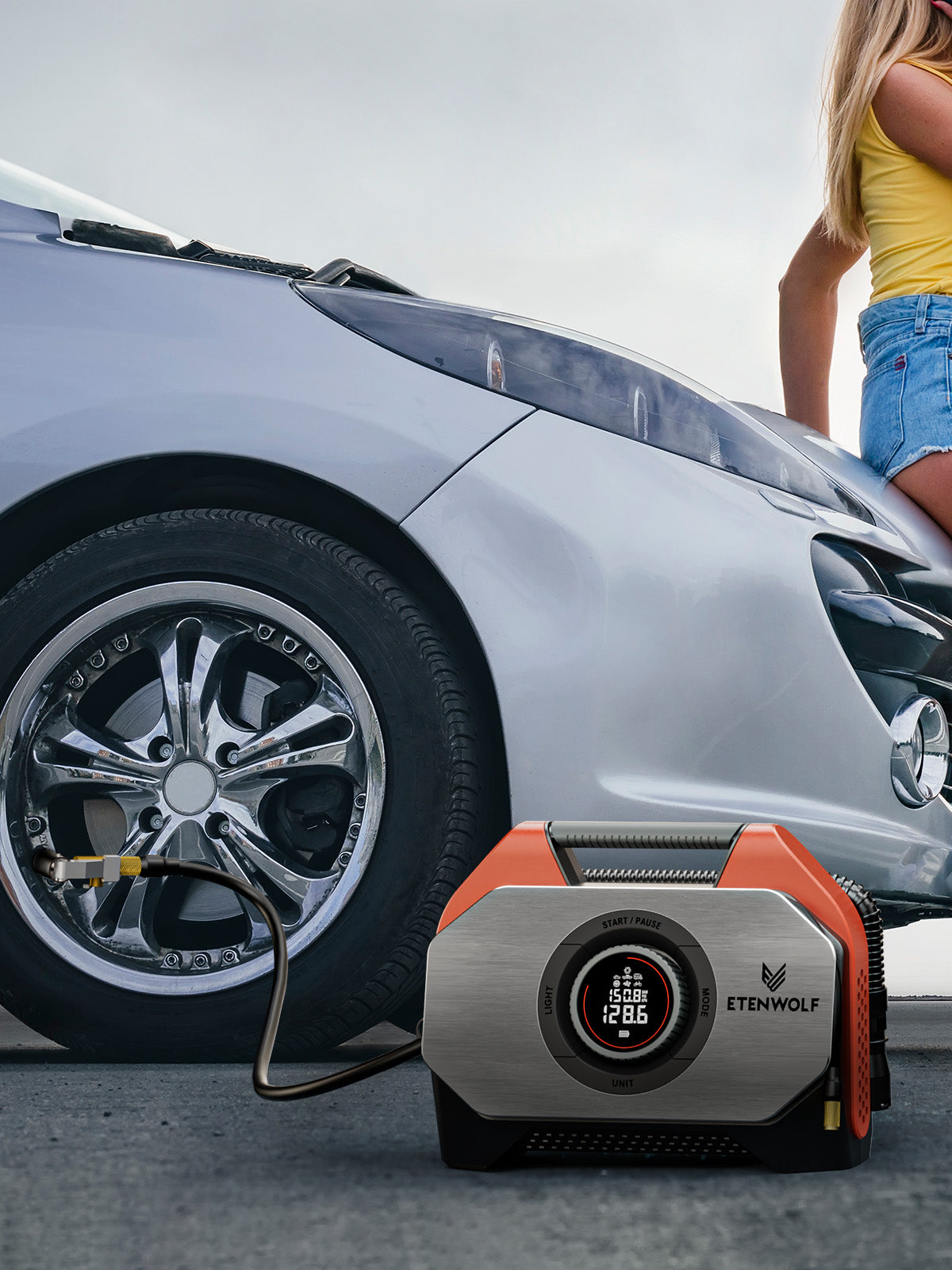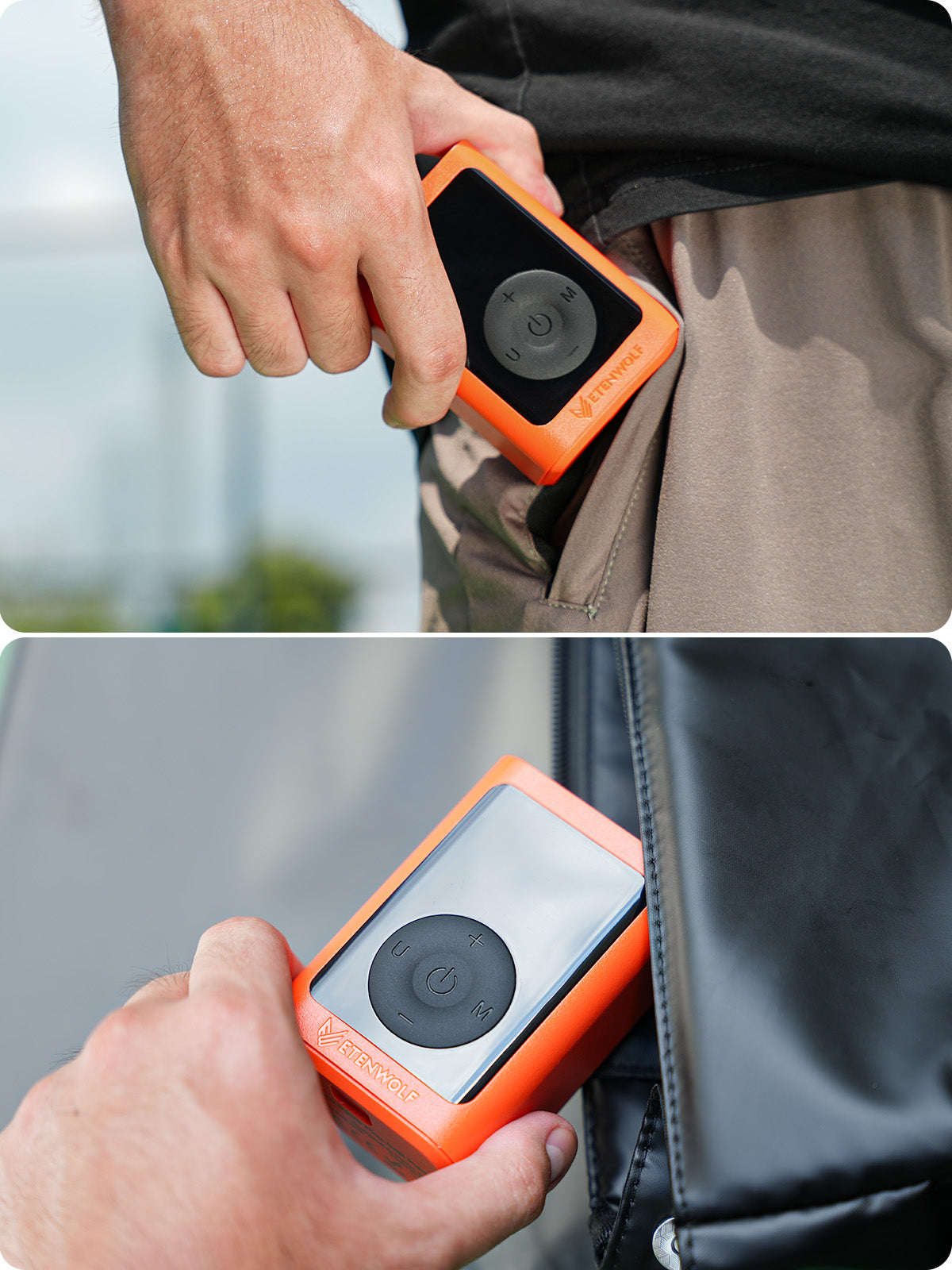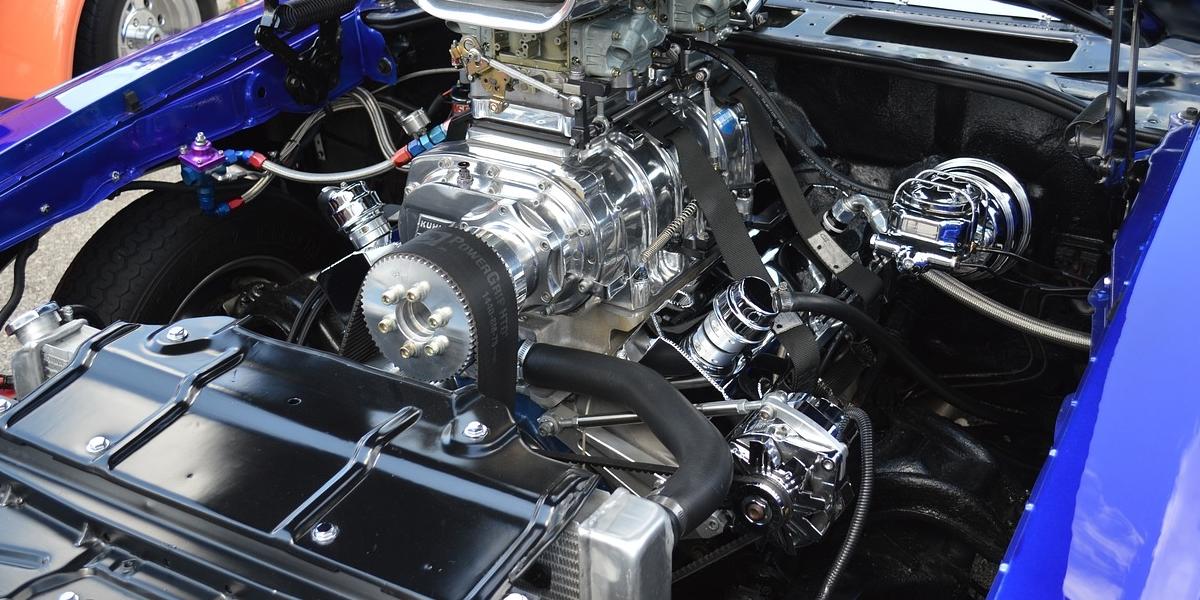Battery capacity remains a technical specification found in product specs but most consumers fail to understand its meaning. Capacity serves as the essential specification which reveals how many times a device can operate between charging cycles when purchasing phones or power banks or electric vehicles or cordless tire inflators. The extended guide explains battery capacity in basic terms while explaining measurement methods alongside comparing typical values between products and demonstrating why ETENWOLF's Vortex S7 establishes new standards for cordless inflators through its 38,400 mAh battery and 260W dual-motor system.
1) What is battery capacity? mAh vs Wh (the short answer)
The storage capacity of batteries measures their ability to hold electrical charge together with stored energy. The measurement of battery capacity exists in two primary forms.
· mAh (milliamp-hours) — this gives the amount of charge the battery can deliver at a given nominal voltage. The measurement of mAh serves as a standard unit for phone batteries as well as power banks and portable electronic devices.
· Wh (watt-hours) — this measures energy (voltage × current × time). Wh is more general and useful for comparing batteries that operate at different voltages (like comparing a 3.7V cell and a 7.4V pack).
Conversion formula:
Wh = (mAh × V) / 1000
(The formula shows mAh = Wh × 1000 / V. The major portable-power brands provide step-by-step explanations about this conversion process in their guides. (Source)
The use of mAh and Wh units becomes necessary because mAh works well for devices using the same voltage chemistry (power banks quote mAh at 3.7V cell level) but Wh shows total usable energy and airports and regulators along with EV makers prefer this unit.
2) The testing methods for battery capacity measurement result in variations between advertised values and real-world performance.
The testing process for capacity involves operating batteries at defined conditions which include controlled temperatures together with consistent discharge rates following a fresh charge. Various real-world factors decrease the actual capacity of batteries:
· Voltage conversion losses — power banks step battery voltage up to 5V USB levels; conversion is not 100% efficient.
· Discharge rate (C-rate) — high power draws reduce usable capacity (batteries under high load show lower effective capacity).
· Temperature — cold reduces apparent capacity; high heat accelerates aging.
· Aging/cycle life — batteries lose capacity with charge/discharge cycles.
The usable Wh output of a 20,000 mAh power bank at 3.7V will be reduced because of conversion losses. Jackery and Anker provide precise Wh↔mAh conversion information along with engineering guidance on their help pages. (Source)
3) Battery chemistry matters: the types behind capacity
The different battery chemistries exhibit different levels of energy density (Wh per kilogram) together with cycle life performance and safety characteristics and production expenses.
· Lithium-ion (Li-ion) — the most common for portable electronics; good energy density and mature manufacturing.
· Lithium-polymer (Li-Po) — similar chemistry with slightly different packaging that can be lighter or slimmer.
· Nickel-metal hydride (NiMH) and lead-acid — older chemistries; lead-acid used in car starter batteries and some heavy equipment.
The true power of battery performance comes from energy density (Wh/kg) together with continuous discharge capability rather than just looking at capacity numbers (mAh). A battery pack designed for both high capacity and sustained high-current discharge is required for inflators that need prolonged high power operation.
4) Typical battery capacities across devices — what to expect
To give context, here are common ranges:
· Smartphones (2023–2025): 3,000–5,000 mAh typical. Flagships often 4,000–5,500 mAh.
· Tablets / small laptops: tens of Wh (e.g., 30–70 Wh).
· Power banks: 5,000–30,000 mAh (the larger 20,000–30,000 mAh models are common); note Wh conversion limits for air travel.
· Cordless tire inflators (typical market models): ~2,600–7,800 mAh in most consumer portable units (listings on retail platforms show many 2,600–7,800 mAh models). For example, several popular inflators on major marketplaces list 7,800 mAh as a selling point.
Consumer demand for increased pack capacity has become prevalent in the cordless inflator market because users require multiple filling sessions and dependable performance for cars and SUVs and occasional truck use.
5) Why battery capacity matters for cordless tire inflators
The performance of a tire inflator depends on its battery capacity to achieve three essential functions.
· The amount of tires you can inflate before needing a recharge depends on battery capacity size because higher capacity means more inflations are possible. A small 2,600–3,000 mAh pack will allow you to inflate one or two car tires but a larger pack will increase that capability. The product manuals and retail listings show how many inflations a battery can support before needing a recharge.
· The operation of big tires which include truck and RV and off-road tires needs higher volume and higher PSI air pressure. Both energy storage capacity and long-lasting power supply at high current rates are required to meet these needs.
· The ability of devices to survive emergencies becomes essential when you need to fix flat tires on trips or during emergency situations.
Market research indicates increasing consumer interest in strong portable inflators because SUV and truck ownership is expanding while electric vehicle adoption increases. The automotive tire inflator market surpassed USD 1.4B in 2024 value and continues to grow with cordless units leading the market advancement. (Source)
6) Power (Watts) vs. capacity (mAh): they’re both critical
Having a device with a large mAh number does not guarantee sufficient performance. The speed of inflation depends on the power capability of the motor or electronics since it measures how many watts they can continuously draw. For example:
· The slow inflation rate of a weak motor inflator with a 7,800 mAh battery makes it inefficient.
· A device featuring a strong motor alongside a minimal battery will provide fast inflation at first before running out of power because of its limited capacity.
High-performance inflators require batteries that provide multiple inflations while using motors that deliver high watts of power along with cooling systems to avoid overheating.
7) Real-world inflator capacity examples (retail products)
· Several midrange inflators come with 7,800 mAh batteries which promise two to three car tire inflations from a single charge.
· Premium cordless inflators use bigger batteries in combination with strong motors and cooling systems because users want quicker inflation time for SUVs and light trucks and off-road tires. Consumer feedback in market reports and product evaluations demonstrates that road trip readiness and emergency preparedness drive customers to choose these features. (Source)
8) Enter the ETENWOLF Vortex S7 — what makes it different
Now we get to the practical payoff. The Vortex S7 from ETENWOLF follows the design principle of never forcing users to choose between speed and endurance. It pairs:
The ETENWOLF Vortex S7 comes with a 38,400 mAh battery that represents one of the largest battery capacities available for cordless inflators combined with 260W ultra-high power dual motors which achieve quick inflation at 30″ SUV tire speed with ±1 PSI auto stop functionality.

Let’s unpack why that combination is special.
9) Why 38,400 mAh is a game-changer (and what it means in Wh)
The conversion of mAh to Wh enables devices to be compared to each other. The Vortex S7 operates at 3.7V nominal voltage.
· 38,400 mAh × 3.7 V ÷ 1000 ≈ 142 Wh
The S7 maintains reliable performance of multiple high-power inflation cycles since its battery matches that of some laptop batteries and large travel power banks and exceeds multiple carry-on power bank specifications. The 142 Wh (approx.) value provides extended power supply to operate strong motors repeatedly. The unit can perform additional functions like emergency power banking for phone charging through USB-C ports because of its capabilities.

10)The device features dual motors together with 260W peak power to deliver speed advantages
The combination of an advanced battery and effective motors ensures fast energy conversion into powerful airflow. The dual motors on the S7 reach 260W power output which allows for both rapid airflow and fast pressure boost generation. The end result results in faster inflation times than competitors' single-motor inflators that use lower power levels. Retail inflator listings show that their product inflates car tires in 1–4 minutes yet the S7 inflate big SUV tires in just 30 seconds making it ideal for emergency situations.

11) Thermal management & duty cycle — crucial for reliability
The operation of high-power motors produces heat as a byproduct. The absence of active cooling along with a duty cycle design limitation forces devices to either throttle down or stop operating for cooling purposes. The ETENWOLF S7 includes active cooling together with a reliable duty cycle that makes it possible to run continuous high-power operations without overheating. Users who need to inflate multiple large tires sequentially (such as RV preparation or fleet maintenance) find this feature essential.
12) How big batteries change user behavior and use cases
The large capacity battery in this cordless inflator allows users to:
· The device enables users to inflate numerous vehicle sets during family road trips and small fleet service operations without needing to recharge.
· The device enables secure inflation of bigger tires which includes SUVs, light trucks and RVs that other inflators fail to handle.
· The device functions as a versatile tool which includes phone power bank capabilities as well as LED lighting for emergency situations.
· The inflator functions as a dependable backup power source for situations where main electricity supply is unavailable including remote locations and emergency events.
The documented market demand for users who need portability with capability is explained by these use cases. Credence and Cognitive Market Research show strong market growth in automotive tire inflators and cordless models capture increasing market share.
13) Regulatory & practical notes (air travel / battery transport)
Airline restrictions apply to large battery capacities because they prohibit power banks and battery packs that exceed specific Wh thresholds. Any travel by air requires verification of device airline rules. Most airlines enforce a 100 Wh power bank limit (check airline policies and subject to possible changes) but larger units need prior approval from airlines. Always verify regulatory requirements before transporting large battery packs for air travel. Check manufacturer product pages for any specified restrictions. The resources about battery conversion and airline rules provide general guidance for conversions.
14) Final thoughts: Why the Vortex S7 is the “culmination” of cordless inflator technology
To be considered the pinnacle of a technology a product must demonstrate engineering excellence that surpasses basic specification value. The S7 integrates three essential features into its design.
· The 38,400 mAh battery capacity in the S7 delivers power equivalent to a large power bank at 142 Wh which supports extended operation time and repeated use for big-tire inflations.
· The dual motors of the S7 deliver fast inflation speed at 260W continuous power which proves essential during time-critical situations (such as roadside emergencies or RV preparation).
· The device functions in multiple real-world situations because it features active cooling and precision auto-stop functionality alongside LED lighting and USB-C power utility.
The S7 functions as a system which unites energy storage with power transformation and temperature regulation and functional elements into a compact portable device. The device achieves leadership status in cordless tire inflators because of its combined features.







Leave a comment
All comments are moderated before being published.
This site is protected by hCaptcha and the hCaptcha Privacy Policy and Terms of Service apply.